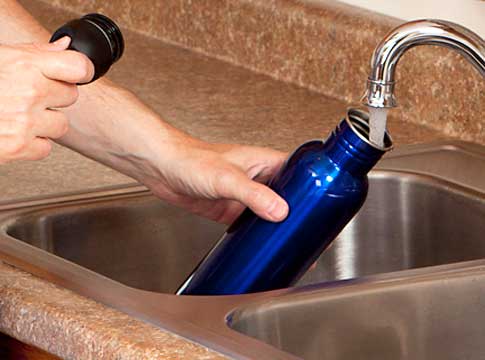Questions about backflow prevention?
Send us an email or call 541-984-4747.
Keep your water drinkable
When you turn on your tap, you expect the water to be pure, healthy and tasty. You can keep your water safe and drinkable if you know how water in your pipes can be contaminated.
Beware of cross-connections
You create a temporary cross-connection when you put a garden hose into a bucket of soapy water while washing your car. In plumbing, a cross-connection is created when your building's pipes or hoses are connected to a system or container that holds anything other than pure drinking water.
Backflow happens
When you turn on the tap to get a refreshing drink, water flows because the pressure in the distribution system pushes the water out of the pipes and into your glass. Unfortunately, a sudden change in water pressure sometimes can cause the water to flow backwards. This unexpected reversal of flow can allow contamination to flow back into your water supply, which is why it is called backflow.
Prevention is best
Thankfully, most plumbing fixtures and appliances that you buy have built-in backflow prevention. For example, the faucet on most sinks are installed above the basin, preventing a backflow. But some systems don't have backflow prevention features. Devices and assemblies are added to such systems to protect the purity of your drinking water. If you have a backflow prevention assembly, it must be tested every year to make sure it is working.

Photo Courtesy of the City of Albany
Systems that need added backflow prevention
The state of Oregon and EWEB requires a properly installed backflow prevention device or assembly where each of the following system connects to the drinking water supply:
- Landscape sprinkler systems
No one wants to drink pet waste, fertilizers and pesticides that could seep into sprinkler piping. - Pools and spas
You might gulp a few mouthfuls of water from your pool or spa, but the chemicals used to kill germs in pools and spas are not good for regular drinking, cooking or bathing. - Heating, cooling and fire sprinkler systems
If you have seen the stagnant water in a fire sprinkler system or the chemicals used to prevent corrosion in a heating or cooling system, you know that such water should not be used for drinking or bathing. - Wells
You expect high quality drinking water that is filtered, disinfected and delivered to your tap. The quality of water from a well is unknown and does not belong in your drinking water system.

Useful links for preventing backflow
EWEB-facilitated commercial backflow prevention assembly testing
Certified backflow prevention assembly tester list
Brochure about how to keep your water drinkable
Backflow Assembly Tester Code of Conduct
Backflow Database Agreement (Use by Backflow Testers only)
Backflow Database Agreement Addendum (Use by Backflow Testers only)

